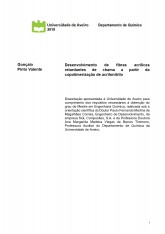resumo
The SGL Composites Company, producer of acrylic fibers, proposed the expansion of their product portfolio by developing flame retardant acrylic fibers via the copolymerization of acrylonitrile. Four alternatives were studied to start the polymerization of acrylonitrile by suspension in aqueous dispersion, continuously and at pilot scale. From this study, the strategy that minimizes the process duration up until the obtained polymer is within the desired specifications regarding its specific viscosity was selected. This strategy was validated by the characterization of the flame retardant polymer obtained namely in terms of dissolution, syrup production, bench extrusion and preparation of coagulated acrylic fibers. In parallel, the effect of additives on the flame resistance of the textile acrylic fiber was assessed. The flame retardant effect of the coagulated fibers was evaluated by measuring its limit of oxygen index (LOI), having obtained values of LOI higher than 25 % in some of the tested conditions. Thermal analyses carried out by differential scanning calorimetry (DSC) and studies regarding the morphology by scanning electron microscopy (SEM) were also performed.\\\\r\\\\nEven though it wasn’t possible to develop the flame retardant acrylonitrile copolymer due to logistics related constraints (delay in the reception of the comonomers), the obtained results allowed the optimization of the initial conditions of the polymerization, as well as the flame retardant properties of the acrylic fiber.
autores
Gonçalo Valente
nossos autores
orientadores
Professora Doutora Ana Margarida Madeira Viegas de Barros Timmons and Doutor Paulo Fernando Martins de Magalhães Correia



